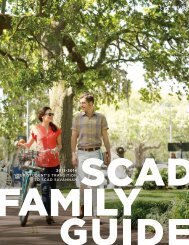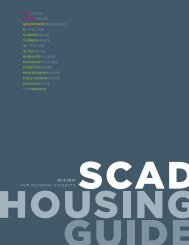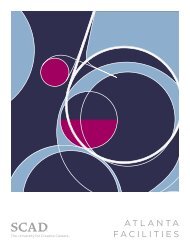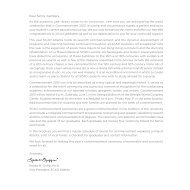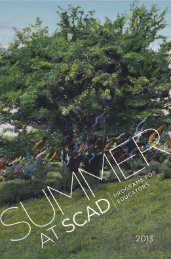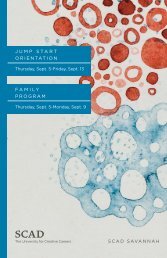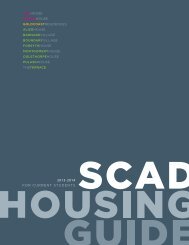View the exhibition catalog. - SCAD
View the exhibition catalog. - SCAD
View the exhibition catalog. - SCAD
Create successful ePaper yourself
Turn your PDF publications into a flip-book with our unique Google optimized e-Paper software.
But this has turned out not to be <strong>the</strong> case.<br />
Aware of <strong>the</strong> trap set beneath his feet, he has<br />
preferred to turn himself into a narrator and<br />
to enter into <strong>the</strong> necessarily fictitious world of<br />
artistic creativity in order to recount for us <strong>the</strong><br />
incoherent details of <strong>the</strong> society in which he<br />
lives. His gaze betrays no anger, just an acute<br />
sense of irony, a disabused look of amusement,<br />
a clear acknowledgment of <strong>the</strong> facts, done in<br />
a joking way. Before turning toward video, he<br />
chose photography as his primary medium,<br />
undoubtedly because of <strong>the</strong> documentary<br />
nature of <strong>the</strong> photographic print. Whe<strong>the</strong>r<br />
we like it or not, photography still makes us<br />
believe that what it reveals to us necessarily<br />
contains a slice of truth. With his constant<br />
mises en abyme (“placing into infinity”), <strong>the</strong>se<br />
self-reflexive embeddings he shows us in<br />
his photographs, Bourouissa has decided to<br />
play on this slice of truth and to deconstruct<br />
things to his heart’s content. He makes light of<br />
clichés and received ideas while making <strong>the</strong>m<br />
his own, adopting an intelligently distanced<br />
attitude that turns to ridicule French society’s<br />
most consistently recurring prejudices simply<br />
by staging <strong>the</strong>m. With dark humor, his<br />
tableaux are composed like a classical painting,<br />
underscoring all <strong>the</strong> contradictions inherent<br />
in that society. The models are chosen with<br />
care. Their clo<strong>the</strong>s perfectly cling to <strong>the</strong>ir<br />
roles, and <strong>the</strong>ir attitudes are meticulously<br />
choreographed by a stage director who is a<br />
stickler for details. And Bourouissa succeeds<br />
in creating <strong>the</strong> illusion he wishes to achieve.<br />
These young people who are playing <strong>the</strong>ir own<br />
roles have necessarily entered into what Jean-<br />
Paul Sartre had called <strong>the</strong> process of splitting.<br />
In becoming aware of <strong>the</strong> image <strong>the</strong>y are<br />
projecting within society, <strong>the</strong>y become o<strong>the</strong>r,<br />
abstractions, thinking beings who are making<br />
an ontological and political comment on <strong>the</strong><br />
gaze of those who want to trap <strong>the</strong>m within<br />
<strong>the</strong> image <strong>the</strong>y have agreed to take on. This<br />
is a fool’s game, a game of mirrors, in which<br />
those who thought <strong>the</strong>y were looking are in<br />
fact those who are under <strong>the</strong> watchful eye<br />
of o<strong>the</strong>rs. The mirror affords this necessary<br />
splitting. What is expressed here is <strong>the</strong><br />
impossibility of being “one,” <strong>the</strong> fact that this<br />
reflection of ourselves comes back deformed<br />
because it is but a reflection. This is <strong>the</strong><br />
reflection of a subject, no doubt, but still more<br />
it is a reflection of <strong>the</strong> world that surrounds<br />
this subject and of <strong>the</strong> setting that conditions<br />
<strong>the</strong> subject and dictates to him his humanity.<br />
Bourouissa’s work is eminently political, even<br />
though he would undoubtedly refrain from<br />
saying so. For, in being content to be a neutral<br />
observer and in being persuaded that <strong>the</strong>re is<br />
no need to add anything to <strong>the</strong> obvious facts<br />
he reveals, he becomes subversive. He starts<br />
to sing a sometimes forgotten hymn, <strong>the</strong> one<br />
Ernst Bloch had called <strong>the</strong> “key question:” <strong>the</strong><br />
self-contained question of “we.” For, in every<br />
“we,” <strong>the</strong>re is first of all an “I.” And how will<br />
we ever succeed in constructing a way of living<br />
toge<strong>the</strong>r that accepts difference as an item of<br />
wealth, as <strong>the</strong> sole guarantee of our aptitude<br />
for humanity? These are <strong>the</strong> pressing questions<br />
raised by Bourouissa’s photographs, <strong>the</strong><br />
violence of which appears so contained. And<br />
<strong>the</strong> French Republic–this symbol represented<br />
by blue, white and red–had better watch out,<br />
if it proves incapable of loving and protecting<br />
its children. All its children.<br />
Translated from French<br />
by David Ames Curtis.<br />
left: Le cercle imaginaire, 2008



